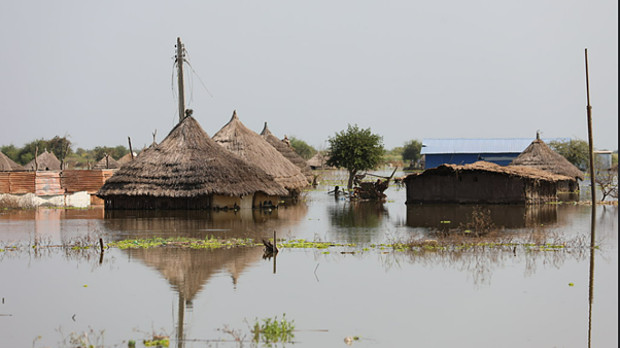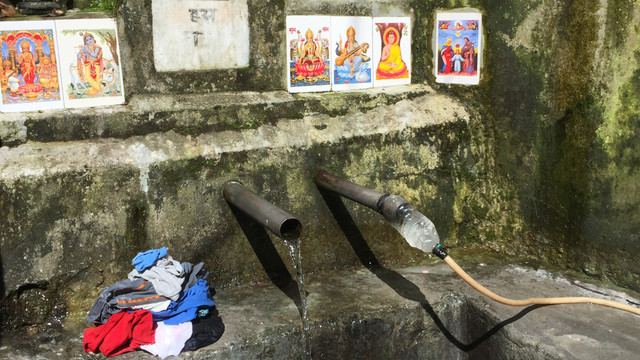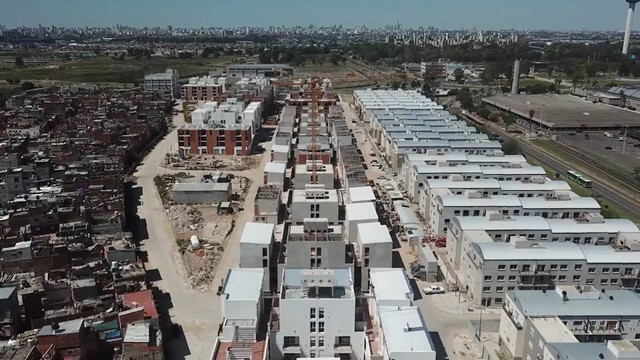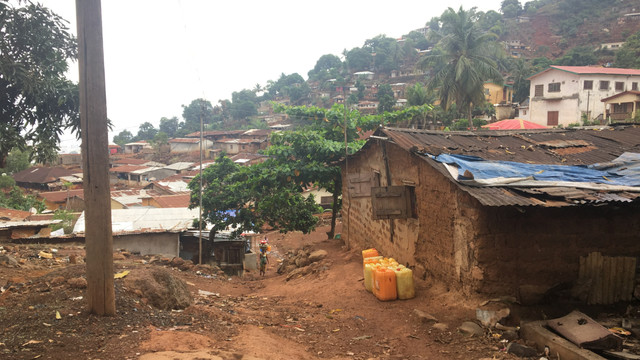Making the most of migration: mobility in the context of the climate emergency
Cities should recognise migrants and forcibly displaced people as city residents and incorporate them into planning processes, including climate-resilience planning.

Flooding in Bentiu, South Sudan, in December 2021. It is estimated more than 200,000 people were displaced following the worst floods in 60 years (Photo: UNMISS, via Flickr, CC BY-NC-ND 2.0)
IIED’s framework for a transformative urban recovery includes calls for the inclusion of migrants, refugees and internally displaced persons (IDPs) in pandemic assistance.
Building on the notion of an inclusive city, a ‘better city’ would prepare, where possible, for the arrival of new populations. It would incorporate migrants and forcibly displaced people in neighbourhood and municipal planning processes and take their views on board in decision-making forums, including for climate-resilience planning.
In this way, rather than seeing IDPs and migrants as a transient population or a humanitarian caseload, they are recognised as city residents who make social, economic and political contributions to urban life.
The problem
Academic and policy debates on climate change and migration have tended to centre on international flows of people from the global South to the global North. Less well recognised in public and policy discourse are projections of the huge scale of likely internal migration in countries of sub-Saharan Africa, South Asia and Latin America.
The World Bank recently predicted that by 2050, over 143 million people from these three regions will have had to move within their own countries as a result of slow-onset impacts of the climate emergency.
We know that the destination of choice for IDPs and migrants is generally urban. Many settle in new or expanding informal settlements, where they may be at further risk of the impacts of climate change. With limited social capital and local knowledge, these new arrivals are often highly vulnerable to harassment and abuse, and unable to access basic services.
Where cash or in-kind support is made available to those who have been forcibly displaced – as a result of disasters for example – assistance is often emergency focused. This means it is short term and aims to encourage people to return to their place of origin. But this fails to recognise that many people who are displaced cannot or do not want to return.
While for some the move to a town or city may be permanent, this does not mean that they cease all contact with their place of origin. Indeed, ongoing connections between urban and rural areas may be key for livelihoods and resilience-building in both locations. Examples of these connections between urban and rural areas include seasonal migration, people sending remittances home or visiting family.
In addition, academic studies on migration tend to focus on predictions and modelling, rather than on the nature and impacts of journeys that are already happening. We know little, in general, about the experiences of migrants and IDPs in cities, or how they adapt to urban life while maintaining contacts with their places of origin.
Depending on the political context, they may choose to live ‘under the radar’ and avoid contact with the authorities. Opportunities are often limited for new arrivals to benefit from local community organising, or contribute to discussions on the future of their neighbourhood or city.
The solution
This situation calls for a policy response – from national governments and international agencies – to provide much-needed support to local authorities in urban receiving areas to prepare for and manage the arrival of migrants and IDPs.
Governments and international agencies must also work with grassroots groups and civil society to extend support to migrants and IDPs, overcoming perceptions that they are transient populations and instead working towards integrating them into the city as residents. This approach should build on promising practices where progressive mayors have sought to incorporate displaced people into responses to the COVID-19 pandemic and the climate crisis.
But they also need to make greater efforts to connect sending and receiving areas, prepare migrants for their journey and ensure the benefits of migration are felt in both sending and receiving areas. This support is critical, given that migrants and those displaced by disaster and climate change are among the most vulnerable urban residents.
However, there are crucial gaps in research, knowledge and data on migration ‘systems’ in the context of climate change. These gaps include insights on points of departure and destination and in understanding how ongoing flows of people, knowledge, goods and capital between rural (sending) and urban (receiving) areas influence decision-making – and their potential to make the migration experience safer and ultimately more successful.
Scholars of environmental migration (paid access only) have typically built quantitative models that predict the likelihood or volume of migration: "After the prediction, however, we stop. Migration is clearly part of a system, one that influences sending and receiving areas beyond the immediate term." New studies are needed that explore migration through a systems framework and that investigate feedback loops and remittances.
Understanding these systems is particularly critical given the climate emergency. Migration is likely to increasingly serve as an adaptation strategy. However, migration has always been part of the evolution of society and should be considered a "long-term contribution to climate resilience and adaptation" – not only as a "reaction to environmental change but also as a part of adaptive response to change".
Building on our work
IIED’s Human Settlements research group aims to explore how support for urban IDPs and migrants can be strengthened and how overall governance of internal migration can be improved for the benefit of both sending and receiving areas.
This requires new research, in collaboration with local governments and civil society in both sending and receiving areas, to strengthen positive linkages, improve flows of knowledge and ultimately help both locations prepare for changes in population structure.
Research on urban-rural linkages from IIED has investigated the ongoing relationships between sending and receiving areas in contexts of economic migration, and stresses the importance of the spatial distribution of economic opportunities as a key determinant in migration flows.
New research would build on this by exploring urban-rural linkages in a context of climate change and forced migration. It would respond to the call for greater recognition of the role of local and national institutions in making sure migration is "part of the solution rather than the problem" and for policies that accommodate changes in migration flows, rather than attempt to curtail them.
IIED is already working with federations of the urban poor and university partners in sub-Saharan Africa on urban displacement issues. For example, SDI Kenya is engaging with urban refugee issues with city and national governments through the 'Protracted displacement in an urban world' project.
Their sister organisations in coastal cities of Tanzania, Liberia, Ghana and Sierra Leone are working with the New School for Social Research, a graduate institute in New York, with advisory support from IIED, on incorporating data on migrants and migration patterns into their enumerations with residents of informal settlements.
This work seeks to understand how migrants are impacted by climate change – and are potentially at risk of secondary displacement – in their new places of residence.
All of this research builds on IIED’s history of working with residents of informal settlements to strengthen resilience to climate change. By adding the lens of migration and mobility, we aim to build a full picture of vulnerability and co-produce new practical policy recommendations.
Myth buster: “Climate refugees threaten the peace, security and wellbeing of wealthier nations”
A commonly held myth is that the exodus of millions of climate migrants from poor countries in Africa, South Asia and Latin America will threaten the peace, security and wellbeing of wealthier nations.
Projections of hundreds of millions of ‘climate refugees’ moving from the global South to the global North have been picked up by media outlets. UN and European policymakers posit displacement caused by climate change as a security risk and are entrenching a securitisation agenda, focusing on preventing migration.
However, scholars consider the evidence for these claims "varied and patchy" and made in an absence of "coherent frameworks for thinking about, and testing hypotheses on, environmental change and migration", and "without an empirical scientific basis".
In addition, much academic research is being driven by policymakers who are concerned about the potential numbers of people migrating internationally for environmental reasons now and in the future, where they are headed, and with what social and economic consequences.
This has generated a significant body of work that focuses on identifying environmental risks and modelling potential scenarios. IIED’s new engagement on this topic seeks to dispel the myths driving the current research agenda, and refocus attention on the vital here-and-now of internal migration systems in a context of climate change.
Contact
Lucy Earle (lucy.earle@iied.org), principal researcher, IIED's Human Settlements research group



